PayPal and the credit card industry are taking advantage of consumers


Stablecoins offer a way for consumers — particularly Americans — to escape the financial industry’s punitive transaction fees.
As rising prices have forced consumers all over the world to reduce their spending and find new ways of coping with the increased cost of living, consumers are finding themselves relying on credit cards even more than they already were.
More Americans are unable to pay their credit card bills in full at the end of the month, with 46% of credit cardholders carrying month-to-month debt, up from 39% in 2022. A recent report from the Federal Reserve Bank of New York highlighted how the current 15% year-to-year credit card balance increase represents the largest jump in more than 20 years.
It’s undeniable that ordinary people are facing higher prices across the board, and are increasingly unable to make credit card payments. That’s because payments giants like PayPal are taking advantage of consumers, and we’ve all been letting them get away with it.
As credit card spending in the United States almost entirely benefits Visa and Mastercard, who handle 80% of total transactions, the failure of the competitive model in the credit card industry may be to blame for at least part of the crisis at hand
Related: Did regulators intentionally cause a run on banks?
But that’s not all: With the highest credit card swipe fees of any major economy, American businesses pay up to seven times more in swipe fees than businesses in Europe, and five times more than businesses in China — a cost that gets passed down directly to consumers. In order to avoid shouldering transaction costs, merchants are forced to set higher prices than they would prefer — that’s prices for all consumers, not just those choosing to pay by credit card — which essentially means that anyone paying by cash or debit card is forced to pay a higher price for the convenience of a select few.
It’s true that electronic payments are convenient, and they’ve solved many of the cross-border problems posed by an old cash-only mentality. However, consumers end up paying a lot more for this comfort than they might have been led to believe, and they might not even know it.
In 2023, the technology at our disposal is so advanced that centralized services imposing limits on merchants’ or customers’ rights to send and spend simply should not exist.
Why, in today’s world, should anyone be forced to use a centralized service that is specifically designed to take such a big cut of their every purchase?
By replacing old systems and traditional payment providers — which serve the greater monopoly rather than hard-working ordinary people — distributed solutions can save consumers and merchants more money. In order to do this in a safe and transparent fashion, however, volatility cannot be a part of the equation, which means traditional cryptocurrencies cannot be the answer. But stablecoins could be.
Give me my goddamn money @paypal. I should have conducted this transaction in bitcoin.
— Neeraj K. Agrawal (@NeerajKA) November 11, 2011
Stablecoins are specifically designed for price continuity, as the name suggests. Their value is directly tied, or pegged, to a “stable” reserve asset, like a precious metal or the U.S. dollar, so their price is ultimately fixed. By allowing for real-time payments over blockchain networks, they offer faster and more efficient money movement than their fiat counterparts. With a more concrete value proposition for everyday use, they represent a more effective alternative to more highly volatile cryptocurrencies.
But with some stablecoins going as far as offering 99% cheaper fees for consumers and merchants compared to what the current global payment solution providers offer, they also represent a good way out of our dependency on credit cards as a whole.
In a 2021 speech, the Federal Reserve Board’s vice chairman for supervision, Randal Quarles, invited us to “not fear stablecoins,” as their potential benefits should be taken into “strong account,” and “the possibility that a U.S. dollar stablecoin might support the role of the dollar in the global economy.” Elsewhere in the world, things are moving in a similar direction. For example, the Digital Euro Association sees “automated micropayments as a way for Europe to maintain its digital competitiveness.”
The solution may be found in stablecoins themselves or in the mix between traditional financial structures and the innovations of Web3, and it could be easier to implement than we might think.
Related: Bank collapses are spurring interest in self-custody startups
Since merchants may be reluctant to build up the necessary crypto knowledge they would need to accept stablecoins, they could instead look to providers who would allow them to both accept stablecoins as a currency, and get settled into bankable fiat currency without the need to change accounting procedures. The stablecoin provider could add value, security and transparency to its proposition by getting the stamp of approval of something like a bank guarantee, in which case the value of the stablecoin in question would be fully protected, and consumers’ peace of mind would be assured.
The important thing to remember is that both merchants and consumers — sick of a system keeping them hostage — are desperate for innovative solutions to a crisis that’s been left unchecked for simply too long. To this end, the mainstream use of stablecoins as a means of payment does have the potential to save us from our dependency on the credit card industry and even drive down gouged consumer prices. Their value proposition shouldn’t be overlooked.
What will it take to implement a cheaper, more efficient and straightforward way to conduct business? Are we resigned to letting ourselves be taken advantage of? If the answer is no, then stablecoins and other low-fee Web3 solutions may be where we need to start.
This article is for general information purposes and is not intended to be and should not be taken as legal or investment advice. The views, thoughts and opinions expressed here are the author’s alone and do not necessarily reflect or represent the views and opinions of Cointelegraph















